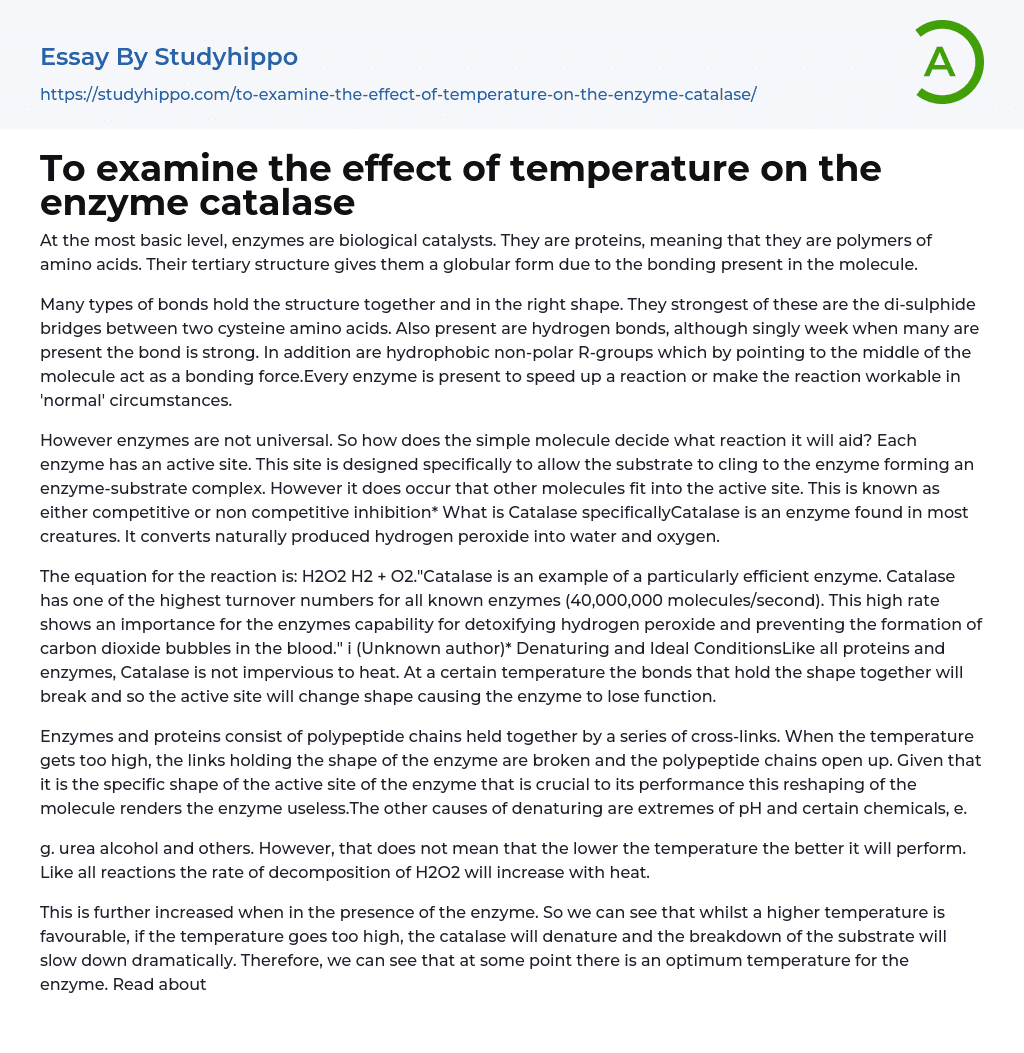

To examine the effect of temperature on the enzyme catalase Essay Example
Enzymes, as biological catalysts, are essentially proteins composed of amino acid polymers. Their tertiary structure results in a globular shape, due to molecular bonding.
Various bonds contribute to maintaining the structure's shape, with the strongest being the di-sulphide bridges between cysteine amino acids. Hydrogen bonds are also present, but their strength increases when many exist. Moreover, hydrophobic non-polar R-groups serve as a bonding force by directing towards the center of the molecule. Enzymes exist to either quicken a reaction or make it possible under normal conditions.
Despite not being ubiquitous, enzymes possess the capacity to discriminate which reaction to catalyze via their unique active sites that aid in the creation of enzyme-substrate complexes. However, there are times when other molecules can fill this site resulting in competitive or non-competitive inhibition. Catalase is an instance of
...an enzyme that can convert hydrogen peroxide into water and oxygen and occurs in various organisms.
Catalase is an extremely effective enzyme that performs a vital function in the body by preventing carbon dioxide bubbles in the blood and detoxifying hydrogen peroxide. Its remarkable capability to convert H2O2 into H2 and O2, with a turnover number of 40,000,000 molecules/second, enables it to accomplish this task. However, just like other proteins and enzymes, catalase can lose its functionality when exposed to high temperatures that destroy its shape and impair its active site, causing denaturation. (Unknown author)*
Enzymes and proteins are composed of polypeptide chains that are interconnected by cross-links. High temperatures can break these links and cause the chains to unfold, resulting in a loss of the enzyme's specific shape. As the active site shape is fundamental to the enzyme's function, this alteration renders
the enzyme ineffective. Other factors that cause denaturation include exposure to certain chemicals and extremes of pH.
The impact of temperature on the performance of H2O2 is significant due to its effect on reactions. Although there are several substances such as alcohol and urea that can also affect H2O2, a lower temperature does not guarantee optimal results. Contrarily, higher temperatures tend to accelerate the decomposition rate of H2O2.
Enzyme function is enhanced by higher temperatures in the presence of the enzyme, but excessive heat can cause a significant slowdown in substrate breakdown due to catalase denaturation, resulting in an optimal temperature for enzyme activity. Like all enzymes, Catalase operates best at a specific pH level. For additional information on 6 Strong Acids, click here.
In the following experiment, the enzyme will be depicted in both a 3D computer-generated model and a structural representation. The pH level will be neutral, or 7. Hydrogen peroxide, a by-product of many intra cellular reactions, is a chemical that remains in a state of dynamic equilibrium when stored in a bottle.
Under appropriate conditions, the decomposition of hydrogen peroxide into O2 gas and water, as well as the reverse reaction, cannot come to a halt. However, in reality, oxygen gas escapes and only water remains. Therefore, expressing the concentrations of hydrogen peroxide in moles per dm3 is not feasible. Instead, we measure it by percentage of volume. Hydrogen peroxide is a byproduct of various intracellular reactions that constantly occur in most organisms.
Catalase is produced to safely and rapidly break down H2O2. This is crucial as the accumulation of hydrogen peroxide in our bodies could
be fatal. Potato is employed because the processes by which both humans and potatoes generate H2O2 are comparable, just as how Catalase is produced and utilized. Thus, this study can have implications for human biochemistry. Nevertheless, employing natural substrates in experiments often raises concerns about accuracy since outcomes hardly ever align precisely.
As the potato plant develops, its tuber grows. In a non-controlled environment, the plant's cellular processes adapt to changing conditions. When harvesting the potato, the cells' processes may not be at the same stage, resulting in varied amounts of Catalase and potentially other reactants across different potato samples.
* To bring about a reaction, what is the process of substrate and enzyme meeting? Ordinarily, the rate is determined by the frequency and speed of collisions among the particles involved. When enzymes come into play, however, the substrate must collide with a specific speed and orientation. This final aspect is essential, as we have previously explained that the enzyme has an active site that precisely matches the shape of the substrate.
Thus, in the event of the substrate colliding from an angle other than that anticipated by the enzyme, the substrate will be discarded just like any other chemical. The substrate enzyme complex lock and key model diagram can be seen below. It is catalyzed by an enzyme and is a formation reaction, whereas the reaction in this experiment entails a division reaction. Nonetheless, the procedure remains unchanged.
- Acid essays
- Calcium essays
- Carbohydrate essays
- Carbon essays
- Chemical Bond essays
- Chemical Reaction essays
- Chemical reactions essays
- Chromatography essays
- Concentration essays
- Copper essays
- Diffusion essays
- Ethanol essays
- Hydrogen essays
- Organic Chemistry essays
- Osmosis essays
- Periodic Table essays
- Ph essays
- Salt essays
- Sodium essays
- Titration essays
- Bacteria essays
- Biotechnology essays
- Breeding essays
- Cell essays
- Cell Membrane essays
- Cystic Fibrosis essays
- Enzyme essays
- Human essays
- Microbiology essays
- Natural Selection essays
- Photosynthesis essays
- Plant essays
- Protein essays
- Stem Cell essays
- Viruses essays
- John Locke essays
- 9/11 essays
- A Good Teacher essays
- A Healthy Diet essays
- A Modest Proposal essays
- A&P essays
- Academic Achievement essays
- Achievement essays
- Achieving goals essays
- Admission essays
- Advantages And Disadvantages Of Internet essays
- Alcoholic drinks essays
- Ammonia essays
- Analytical essays
- Ancient Olympic Games essays



